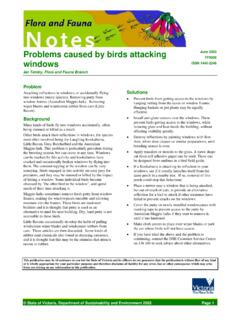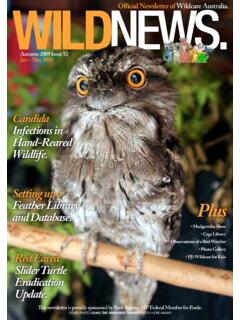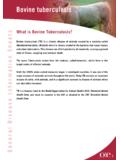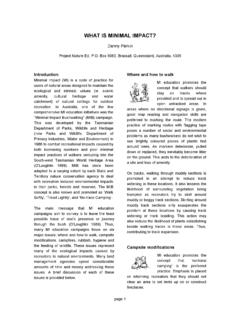Transcription of Planting for wildlife Trees for koalas Coastal south …
1 Trees for koalasCoastal south - east QueenslandPlanting for wildlifeMany secure koalahabitats exist onnational parks,state forests andlocal council parksand reserves but muchof the present koalahabitat occurs onprivately-owned of koalasin the future willdepend largelyon private propertyowners managing theirproperties to retain orimprove koala food treesThe koala is strictly a leaf feeder,using a large number of eucalyptsas well as other species. Koalashave strong regional preferencesfor certain eucalypt a particular district, koalasmay feed almost entirelyon one or two , particular treesare singled out for following Trees arerecognised as important foodtrees in south - east red gum or Queenslandblue gum (Eucalyptus tereticornis)This is one of the most important foodtrees in queensland . Growing 20 to40m tall, this species is found through-out the Coastal area, mainly on alluvialflats, or other fertile soils on hill slopesand mountains.
2 The smooth bark isshed in irregular plates with white,grey and bluish patches. Flowers areusually white but can be (Eucalyptus microcorys)This species occurs in moist eucalyptopen forest on a range of soil found on hilly areas in fertilesoils, tallowwood will grow on ratherpoor sand if subsoil moisture isadequate. Creamy white flowers in latewinter-spring (sometimes summer)and grows up to 40m. The roughred-brown bark is soft and grey gum(Eucalyptus propinqua)Irregular and mottled bark patchescharacterise this medium to tall foresttree. It will grow 20 to 35m tall on awide range of soil types but prefersmoist, well-drained gravelly soils withsome clay content. Flowering periodsfrom January to stringybark(Eucalyptus resinifera)This species prefers sandy or well-drained soils with adequate soilmoisture. Grows 20 to 45m andflowers in spring and red to grey bark is roughand food and habitattreesKoalas are also regularly seen in othertree species that are used either as afood source or provide importanthabitat.
3 These tree species providegood shade and shelter or have othersuitable characteristics that makethem suitable for Trees also provide otherbenefits such as erosion protection,food sources and nesting sites forother mammals and gum(Corymbia citriodora) (previouslyknown as Eucalyptus maculata)Medium to large tree (25 to 40m).Found on heavy-textured, well-drainedsoils on slopes and ridges. The barkhas distinctive dimples. FlowersMarch to gum(Eucalyptus racemosa)(previouslyknown as E. signata)Small to tall forest tree , grows upto 20m. Occurs in Coastal smooth white bark withscribbly patterns made by bark-boringinsects. Prefers clay to sandy, poorly-drained soils. Small white flowers fromJuly through to white stringybark(Eucalyptus tindaliae)Canopy of this moderate sized treehas a silvery appearance. It has roughfibrous bark that persists tothe top of the trunk and 20 to 30m.
4 Flowers Februaryto conservation ofmany wildlife species,including koalas ,depends partly onkoala habitat onprivate landbeing retainedor a r e f o r o u r w i l d l i f eVisit us online at State of queensland . Environmental ProtectionAgency. JAN 2002 Printed on 100% recycled paperQueensland grey ironbark(Eucalyptus siderophloia) (previouslyEucalyptus drepanophylla)Grey ironbark usually occurs insheltered valleys with alluvial soils onedges of flood plains. Also grows onslopes on a range of soil species grows to 30m and flowerswinter-early ironbark(Eucalyptus fibrosa subsp. fibrosa)Moderate sized tree grows 20 to on stony, well-drained soils onridges and slopes. Black, deeplyfurrowed bark (iron bark) and dullgreen leaves. Flowers April to paperbark(Melaleuca quinquenervia)Commonly grows from 8 to 12m butcan reach 25m.
5 Found in coastalareas, along streams, estuary banks,marshes and seasonal swamps. Likessandy, gravelly, swampy soils whereground water is close to the to light-brown papery layers ofcork bark. The loose outer layersbecome torn and ragged, eventuallypeeling off. White to cream flowersmainly from spring to species in the area that koalashave been known to use include: Pink bloodwoodCorymbia intermedia, Broad-leaved white mahoganyEucalyptus carnea, Narrow-leaved ironbarkEucalyptus crebra, Mountain grey gumEucalyptus major, Grey boxEucalyptus moluccana, Narrow-leaved red gumEucalyptus seeana, Brush boxLophostemon confertus, and Swamp mahoganyEucalyptus to grow a treeYou can grow your own native shrubsand Trees from seed. It s easy here s seed to seedlingFirst, choose seeds from a specieswhich grows naturally in your area andis suited to your fine, sandy loam into a shallowplastic container.
6 Put drainage holes inthe bottom of the container anddampen the soil. Tap the surface leveland sprinkle seeds evenly over thedamp surface. Cover the seeds with ashallow layer of loam. This should beno thicker than twice the diameter ofthe the container in a tray of water(which will keep the soil moist bycapillary action) and place in a warm,but sheltered, spot. Germination takesone to four weeks, sometimes longerdepending on conditions. Protect theseedling from drying winds and directmidday seedling is ready to be trans-planted into a pot when a second pairof leaves appears and the seedling isabout 2 to seedlingsPrepare potting mix using sandy loamand well rotted compost 60/40 mixis best and fill medium-sized potsthat are at least 10cm deep. Moistenthe soil and drain before a dibble (8mm dowel sticksharpened to a fine point), remove theseedling from your seed bed, gentlypulling the seedling free.
7 Make a neathole with the dibble in the pot soil andgently lower the seedling s roots intothe hole. Make sure the roots gostraight down and are not doubledover. Firm the soil around the seedling,again using the dibble. Form a shallowSoil typeCompiled for the koala Coast types in other Coastal areaswill support many of these with your local sand to sandy loam topsoilover a sandy to heavy clay most widely occurring soil typebehind the coast occurring on lowhills and dark red-brown coloured loamto clay loam. Generally found along thecoast from Wynnum to Redland Bay,also Rochedale, Sunnybank andEight Mile coloured clay loam to heavy claywith high organic content. Poorlydrained on Coastal plains especiallyalong creeks close to sea intermediaEucalyptus carneaE. fibrosa subsp. fibrosaMelaleuca quinquenerviaEucalyptus majorEucalyptus microcorysEucalyptus propinquaEucalyptus racemosaEucalyptus resiniferaEucalyptus seeanaEucalyptus siderophloiaEucalyptus tereticornisdepression around the seedling andwater seedling can now continue togrow into a small plant.
8 Keep it in awarm sheltered spot until it is readyto be hardened off before Planting outin your garden. Hardening off involvesexposing the plant gradually to theconditions it will have to contend withwhen planted to plantNatural bushland has several layers grasses and herbs form the groundcover, shrubs, the understorey layerand eucalypts, the canopy grow into large treesproviding food and shelter for koalasand other animals including possums,gliders, parrots, honeyeaters andmany very important small insectivo-rous birds and spiders essential to thewell-being of the Australian mix of native Trees and shrubs arebest planted close together (1 to 2mapart) to form a thicket in a corner ofyour yard well away from overheadpower lines and underground leaf litter to accumulate; overthe years these shrubs and treeswill attract many bush creatures toyour citriodoraEucalyptus tindaliaeLophostermon confertusEucalyptus moluccanaEucalyptus crebraTree Planting tableSelecting Trees forplantingTrees for koalas should be selected forlocal soil type or best results, plant species thatoccur naturally.
9 (Refer to table below.)Caution:Heights of eucalypts heights of mature treesbefore robusta











